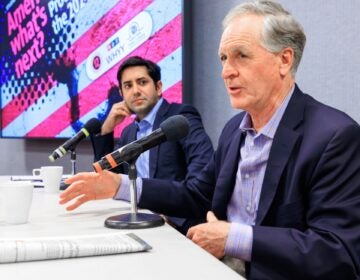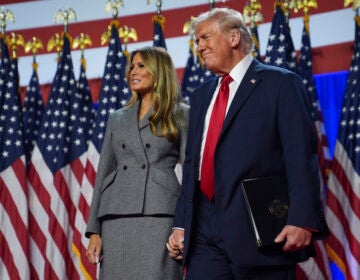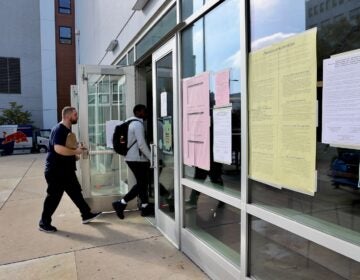Where Trump appeared in 2016, assaults followed, Penn researchers say
Research out of Penn found that cities where Trump appeared during the 2016 campaign experienced a measurable spike in police-reported assaults.
Listen 1:45
People chant toward the media area before a rally with Republican presidential candidate Donald Trump, Saturday, Nov. 5, 2016, in Reno, Nev. (AP Photo/John Locher)
Donald Trump’s rallies during the 2016 presidential campaign attracted gobs of attention both for their unorthodoxy and their aggressive tone, but did they inspire unusual levels of violence?
The answer, according to a group of Philadelphia researchers, is yes.
Cities that hosted rallies for Republican candidate Trump during the campaign saw a 12 percent uptick in reported assaults, according to a study published last week and spearheaded by researchers from the University of Pennsylvania. Cities where Democratic rival Hillary Clinton appeared experienced no discernible change in recorded assaults, the study found.
The authors concede they don’t know why cities saw 2.3 additional police-reported assaults on days they hosted Trump rallies. It could be that increased police presence and vigilance led to more citations.
Or, as lead author Christopher Morrison speculated, the rallies themselves may be the cause.
“It seems the most likely explanation is that Trump rallies themselves lead to violence,” said Morrison, a postdoctoral fellow.
Commentators accused Trump of inciting violence in his campaign speeches, including one incident when he said he’d like to punch a protester in the face. Violence marred several Trump appearances, some of it directed at his supporters and some it perpetrated by them.
The University of Pennsylvania study used publicly available police records and only looked at events in cities with 200,000 people or more. Researchers could not consistently find online records for smaller cities, Morrison said, and worried it would be unwise to include events in small towns because on the day of a large rally their respective populations might mushroom. Because of the population threshold, the rally closest to Philadelphia included in the study was in Pittsburgh.
In all, the study examined 31 Trump rallies and 38 Clinton rallies, controlling for variables such as weather and holidays. The cities examined recorded an average of 19.4 assaults in the four weeks before and after the rallies, but that number jumped to 21.7 assaults on days Trump appeared.
If, indeed, the Trump rallies spurred an increase in assaults, researches also aren’t sure how. The study did not look at where assaults took place, so it’s unclear if an abnormal number of incidents occurred at or near Trump rallies.
There’s also a chance that locals watching Trump on television or reacting to his statements on social media made decisions they otherwise wouldn’t have made, the authors said.
“It is possible that the violent language employed by candidate Trump affected the mood and behavior of other rally attendees, as well as those exposed to the rally through news reports and digital social media, contributing to increased violence across the city,” they wrote in their findings.
Morrison acknowledged there’s still much unknown about why there seems to be a link between Trump rallies and increase assaults. He does, however, believe he and his fellow injury-prevention experts can begin to draw conclusions.
“There’s an important lesson here, which is that rhetoric of our leaders matters,” he said. “The language of our leaders matters and can have a meaningful and measurable impact on public health.”
WHYY is your source for fact-based, in-depth journalism and information. As a nonprofit organization, we rely on financial support from readers like you. Please give today.





